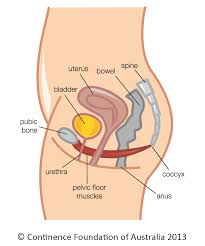The pelvic floor muscles are foundation of the whole body. They are our power centre and a source of our physical strength. These muscles span from the tailbone (coccyx) to the pubic bone; front to back, and also side to side. These muscles are normally firm, thick, and resemble a muscular trampoline in its ability to move up and down. These muscles effectively form a hammock across the base of your pelvis that supports the internal organs above it. Having strong pelvic floor muscles gives you proper control over our bladder and bowels, improve sexual performance, help stabilize the hip joints, balance and stabilize the spine and act as a lymphatic pump for the pelvis.

There’s actually a pretty simple reason why so many women have issues with incontinence, prolapse and both men and women with low back and hip pain…… It’s a lack of connection to the deep core muscles, thanks to the fact that the pelvic floor gets stuck, disconnected, weak, and loses tone because it is an area where we hold stress and tension, and do not talk about it!
In Yoga, the pelvic floor is known as the root or base chakra—it’s where we tend to literally “hold” fears, specifically fears around primary instincts such as our health, our family’s safety, and our financial security. It is a “stress container,” in that it’s where we process the emotion and house our fight or flight reactions. Stress will cause you to clench your pelvic floor (i.e., it feels like a pit in your stomach).
When we lose the connection to these deep muscles, it becomes difficult to relax the area, meaning the pelvic floor becomes perma-flexed. Imagine flexing your bicep constantly and never fully letting go. After a while, this would cause your arm to lose flexibility, strength, and the ability to relax. Therefore the problems with the pelvic floor muscles are not just weakness from lack of connection and use, but also tension and the lack of ability to switch of the stress response in the body. We actually need to willfully relax and unclench these muscles—and then direct energy to build strength.
Finding our pelvic floor muscles : For women
It’s important to activate the muscles that you use cut your pee off mid-stream. To do this, contract, pull up, and hold. You should feel a tightening around your vagina, though try not to tighten your butt or upper belly muscles. Contrast this move by letting go of the muscles: Feel the base of the core relax, and then relax one more layer to fully surrender. If we learn to isolate these muscles with a neuromuscular or brain-body connection in order to activate and relax them then we have the power to control how we deal with stress and learn how to be calm more often which equals a sense of youthfulness

Finding your pelvic floor muscle: For men
Squeeze your anus, imagining you are holding in whatever you need to let out if going to the toilet. Experiment with short, sharp squeezes, and long, hard squeezes. You will start to notice that sometimes it feels like you are squeezing your anus, sometimes deep inside, all the way up to your belly button. After you squeeze in, push out (with an empty bladder) and notice what muscles you are sensing. The pelvic floor has many levels and layers, and to exercise it well, you will need to practice tensing the more outer layers, as well as the deeper, higher, more internal layers.

Weight, Age and Posture
Being overweight can contribute to pelvic floor problems. Posture is another huge factor, the way you sit, stand and move in and out of postures or daily activities, has a big impact on the long-term health of the pelvic floor. There is a correct way to sit, stand and move, and if you have any pelvic floor problems, you really need to pay attention to that. Also as we age we tend to become less active, so our muscles throughout the body become weaker, and we loose our connection with these muscle, having difficulty isolating or activating muscles.
It’s cultivating awareness that is the first step to improving the quality of these muscles and our overall health. Gentle, controlled postures with breathe awareness is the place to start. Take the time to understand your body, it’s the only one you have got, and only you are the only one responsible for it.
